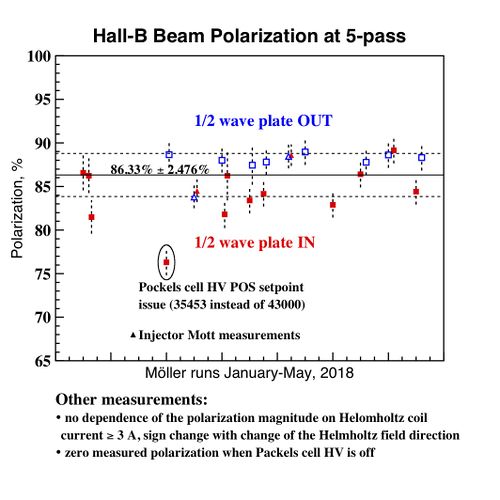Run Group A
Shift ScheduleShift ChecklistHot CheckoutBeam Time Accounting
|
Manuals |
Procedures |
JLab Logbooks
|
If calling local numbers (with area code prefix 757) from the counting room dial 9+[last 7 digits]. To call other area codes dial 91+[10 digit number]
|
| |||||||||||||||||||||||||||||||||||||||||||||||||||||||||||||||||||||||||||||||||||||||||||||||
- Note, all non-JLab numbers must be dialed with an area code. When calling from a counting-house landline, dial "9" first.
- To call JLab phones from outside the lab, all 4-digit numbers must be preceded by 757-269
- Click Here to edit Phone Numbers. Note, you then also have to edit the current page to force a refresh.
Click Here to edit Phone Numbers. Note, you then also have to edit this page to force a refresh.
CLAS12 Run Group A, Spring 2018
Beam energy 10.6 GeV (5 pass)
Important: Document all your work in the logbook!
Remember to fill in the run list at the beginning and end of each run (clas12run@gmail.com can fill the run list)
RC: Lei Guo
- (757) 575-7540
- 9 575 7540 from Counting Room
- lguo@jlab.org
PDL: Eugene Pasyuk
- (757) 876-1789
- 9 876-1789 from Counting Room
- pasyuk@jlab.org
- Note 1: Be very mindful of the background rates in the halo counters, rates in the detectors, and currents in the SVT for all settings to ensure that they are at safe levels.
The integrated rates on UPSTREAM counters has to be in the range 0-15 Hz (rates up 100 Hz are acceptable) and MIDSTREAM has to be in the rage 10-20 Hz (acceptable up to 50 Hz) @50 nA. Count rates in the range of hundreds or more may indicate bad beam tune or bleed-through from other Halls.
- Note 2: At the end of each run, follow the DAQ restart sequence
"end run", "cancel", "reset", then
if run ended correctly "download", "prestart", "iocjscalerRestartAll.sh", "go".
if run did not ended correctly, or ROCs had to be rebooted "Configure", "download", "prestart", "iocjscalerRestartAll.sh", "go".
After DAQ prestart is complete reboot the scaler IOCs with the command: iocjscalerRestartAll.sh.
Note: After each step, make sure it is complete in the Run Control message window. If a roc has crashed, find which one it is and issue a roc_reboot command and try again. Contact the DAQ expert if there are any questions.
- Note 3: Nominal beam positions: 2C24A (X=0.5,Y=0.5) , 2H01 (X=1.0 mm, Y=-1.0 mm) see log entry https://logbooks.jlab.org/entry/3560786.
- Note 4: Do not turn OFF FTOF HVs, even during the beam tune
- Note 5: In case of the Torus and/or Solenoid Fast Dump do the following -
- Notify MCC, request beam OFF and drop Hall status to Power Permit
- Call Engineering on-call
- Make separate log entry with copies to HBTORUS and HBSOLENOID logbooks. In the "Notify" filed add Ruben Fair, Probir Goshal, Dave Kashy and esr-users@jlab.org
- Notify Run Coordinator
- Call the MM expert to turn the detector off
- Call SVT expert to turn SVT off
- Turn off all the other detectors
- Note 6: When beam is being delivered to the Faraday Cup -
- the Fast Shut Down: Upstream, Midstream, Downstream, BOM and Solenoid should be always Unmasked,
- No changes to the FSD threshold without RC or beamline expert approval.
- Note 7: Do not turn on or off SVT - only SVT expert can do that
- Note 8: Any request for a special run or change of configuration has to be approved by RC & documented.
- Note 9: Check carefully BTA every hour and run script btaGet.py . It will print for you what HAS TO BE in BTA for this hour. Edit BTA if it is incorrect.
- Note 10: Reset CLAS12MON frequently to avoid histogram saturation.
Run Plan: April 29-May 2April 29 (Sunday) Day - Aprl 30 (Monday) Owl
Sometimes, a couple of RICH channel scalers would go to 0 and there is no alarm, even though the "# of fjibers connected" would be shown to be the correct 138. Shift takers therefore should periodically, especially at the end of run, check the RICH scalers GUI. If there is an issue, please refer to the instruction below.
In case of other questions or uncertainties of what to do, please call the RC
|
General Instructions:
Every Shift:
Every Run: Log screenshots of:
|
Webcams |
Manuals |
Epics on the web
|
Hall-B
Run lists |
Accelerator |
Bluejean meetings
|


